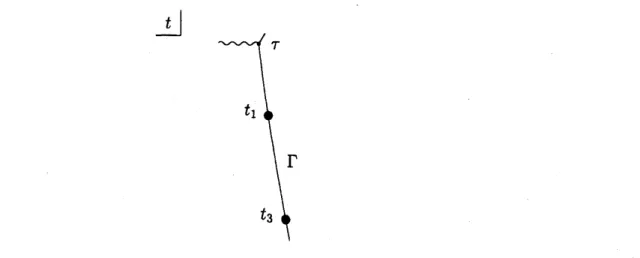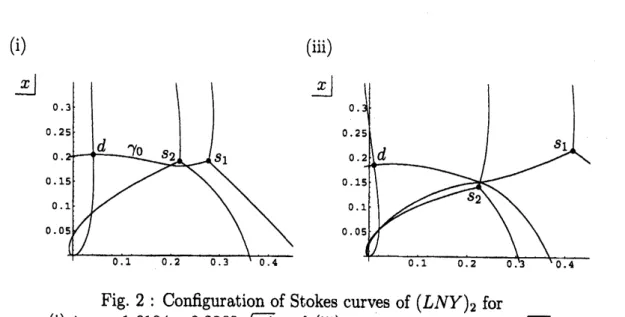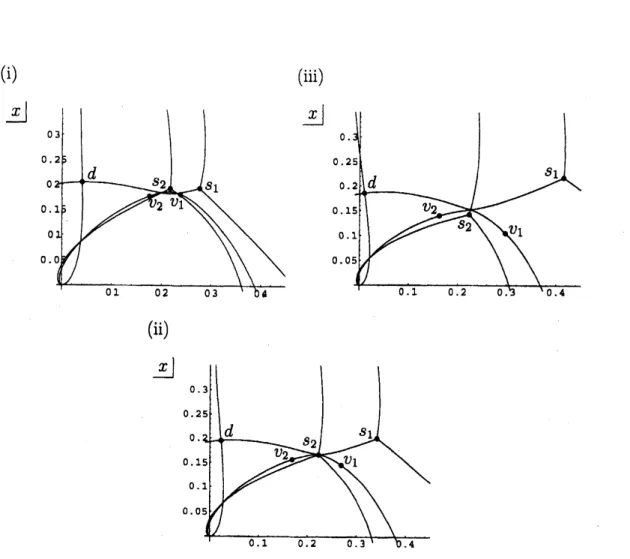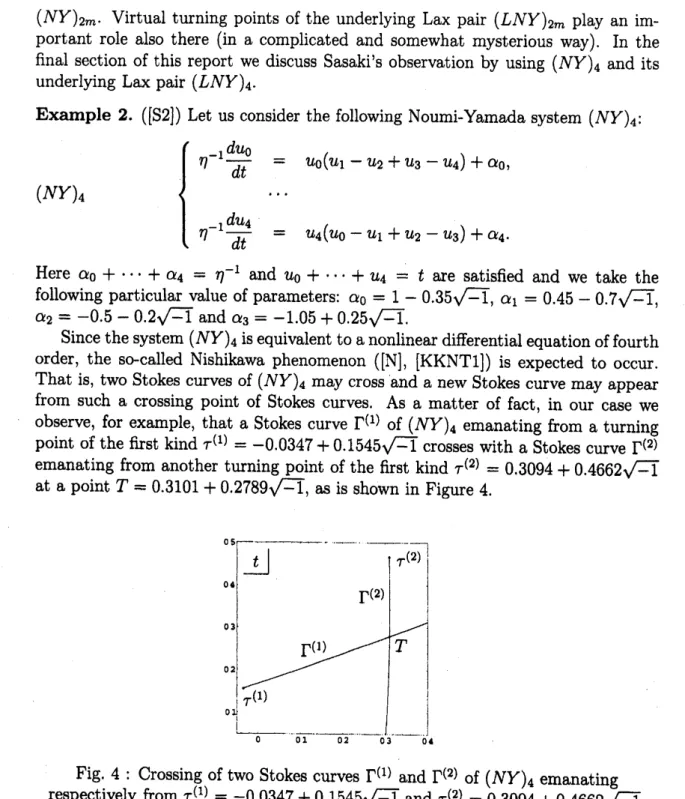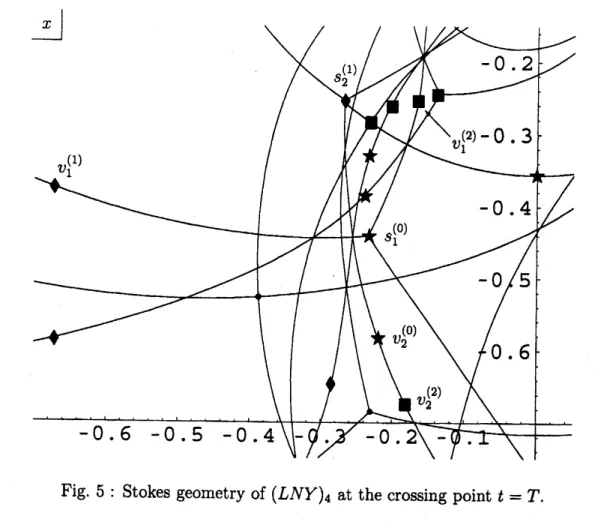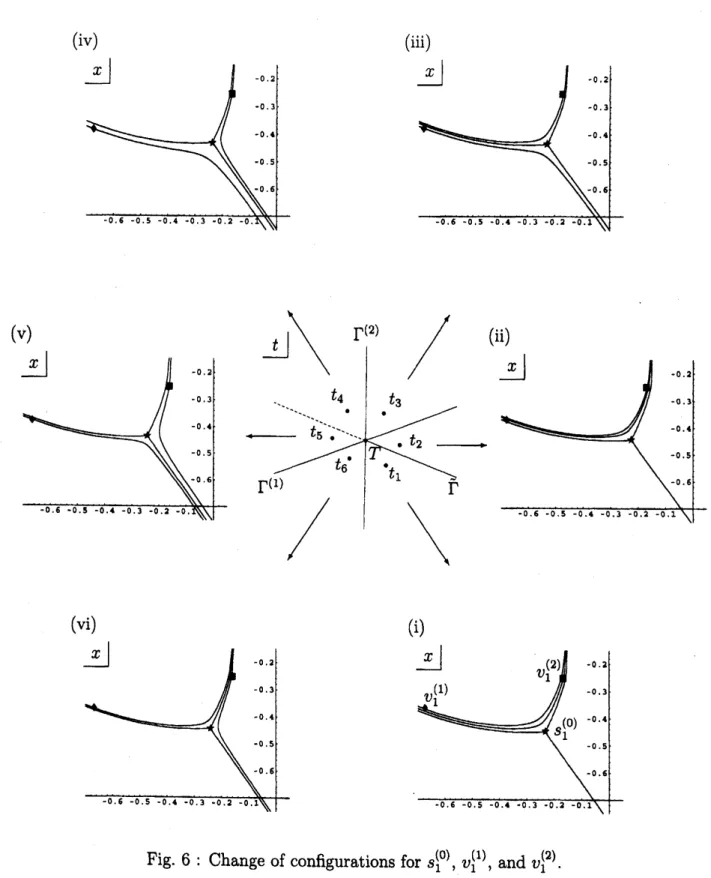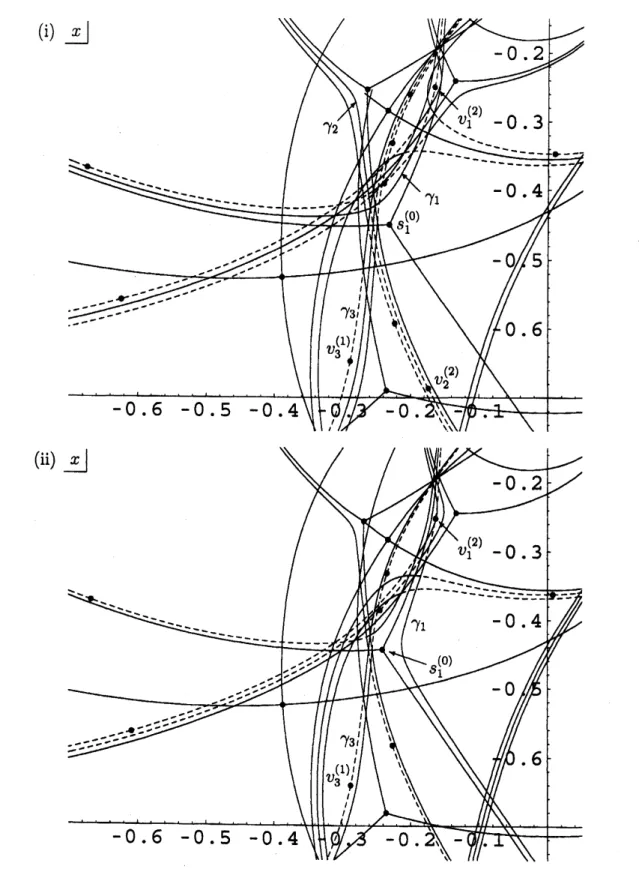Virtual turning
points
and
isomonodromic
deformations
–On
the
observation
of
S. Sasaki
for
the creation
of
new
Stokes
curves
of
Noumi-Yamada
systems
–近畿大学理工学部 青木貴史 (AOKI, T拙ashi)
Department ofMathematics, Kinki University
京都大学数理解析研究所 河合隆裕 (KAWAI, Takahiro)
RIMS, Kyoto University
京都大学理学研究科 小池達也 (KOIKE, Tatsuya)
Department of Mathematics, Kyoto University
京都大学数理解析研究所 佐々木俊介1 (SASAKI, Shunsuke)
RIMS, Kyoto University
京都大学数理解析研究所 竹井義次 (TAKEI, Yoshitsugu)
RIMS, Kyoto University
turning points and Stokes
curves
but also virtual turning points andnew Stokes
curves
of the underlying linear equations should be relevant to the WKB analysisof Noumi-Yamada systems.
As
a
matter offact, Sasaki has discovered in his master thesis and its successivepaper that virtualturning points ofthe underlying linear equations play
a
cruciallyimportant role in the creation of
new
Stokescurves
of Noumi-Yamada systems (cf.[Sl, S2]$)$
.
The purpose of this report is to explain the role of virtual turning pointsin the (isomonodromic) deformation theory of linear differential equations and to
discuss Sasaki’s observation forthe creation of
new
Stokescurves
ofNoumi-Yamada
systems.
The plan ofthis report is
as
follows: We first recall the explicitform
ofNoumi-Yamada
systemsand their underlying linear equations inSection 2. Then
inSection
3
we
review the definition of virtual turning points ofhigher order linear ordinarydifferentialequations. Finallyin
Section
4weexplaintheimportanceof virtualturn-ing points in the deformation theory of higher order equations and discuss Sasaki’s
observation for the relevance ofvirtual turning points to the creation of
new
Stokescurves
of Noumi-Yamada systems.2
Noumi-Yamada
systems of
type
$A_{l}^{(1)}$The Noumi-Yamada system, denoted by $(N\mathrm{Y})_{l}(l=2,3,4, \ldots)$ in what follows, is
a
higher order Painlev\’e equation with affine Weylgroup
symmetry oftype $A_{l}^{(1)}$ (cf.[NY]$)$
.
Itmay
be consideredas
higherorderanalogueof the
fourth
Painlev\’e equationwhen $l$ is
even
and thatof
thefifth
Painlev\’eequation when $l$ is odd, respectively.
As
we
discuss thecase
where $l$ iseven
in thisreport, let
us
give the explicit formof$(N\mathrm{Y})_{l}$ only for $l=2m$ here:
$(N\mathrm{Y})_{2m}$ $\eta^{-1}\frac{du_{j}}{dt}=[u_{j}(u_{j+1}-u_{j+2}+\cdots-u_{j+2m})+\alpha_{j}]$ $(j=0,1, \ldots, 2m)$,
where $\eta>0$ denotes a large parameter, $\alpha_{j}$
are
complex parameters satisfying(1) $\alpha_{0}+\cdots+\alpha_{2m}=\eta^{-1}$,
and the independent variable$t$ and the unknown
functions
$u_{j}$
are
normalizedso
that (2) $u_{0}+\cdots+u_{2m}=t$may be
satisfied.
(It is also assumed that $\alpha_{j}$ and $u_{j}$are
cyclic with respect to theindex $j$ with the cycle $N=l+1.$) In view of (2)
we
find that$(N\mathrm{Y})_{2m}$ contains
$2m$ independent unknown
functions
and is equivalent toa
$(2m)$-th order nonlinearordinary differential equation with
one
unknown function,say,
$u_{0}$.
(For example,The system $(NY)_{l}$ with $l=2m$ describes the compatibility condition of the
following system of linear equations (“Lax pair”) of the size $N\cross N(N=l+1=$
$2m+1)$:
(3) $\eta^{-1}\frac{\partial}{\partial x}\psi$
(4) $\eta^{-1}\frac{\partial}{\partial t}\psi$
where
(5) $A=- \frac{1}{x}$ $.u_{1}x.$
.
and (6)$B=$
$=$ A$\psi$, $=$ $B\psi$, $\epsilon_{N-2}.1.$.
$u_{\dot{N}-2}\epsilon_{N-1}..u_{N-1}\epsilon_{N}1)$ $.-.1$.
$q_{\dot{N}-1}.$.
$-1q_{N})$.
Here $\epsilon_{j}$
are
parametersdetermined
by the relations(7) $\alpha_{j}=\epsilon_{j}-\epsilon_{j+1}+\eta^{-1}\delta_{j,0}$, $\epsilon_{1}+\cdots+\epsilon_{N}=0$
($\delta_{j,k}$ denotes Kronecker’s symbol), and
$q_{j}=q_{j}(t)$
are
functions of$t$ satisfying(8) $q_{j+2}-q_{j}=u_{j}-u_{j+1}$, $q_{1}+\cdots+q_{N}=-t/2$
.
The aimofthisreportisto analyze the
Noumi-Yamada
system $(NY)_{2m}$ from theviewpoint of the exact
WKB
analysis, makingfull
use
of the exact WKB analysis ofthe underlying Lax pair (3) and (4). Note that
we
have introduced the largeparam-eter $\eta$ into $(NY)_{2m}$ and its underlying Lax pair (3) and (4) through
an
appropriatescaling of the variables so that
we
may discuss the exact WKB analysis for them;the original
Noumi-Yamada
system is obtained by putting $\eta=1$.
3
Virtual
turning points of higher order linear
or-dinary
differential
equations
Before
discussing the exact WKB analysis of the Lax pair (3) and (4),we
reviewpoint for
a
systemof first order
linear ordinarydifferential
equationswith size
$m$ $(m\geq 3)$.
(Inthis
report, sincewe are
discussing theNoumi-Yamada
system andits underlying Lax pair,
we
deal witha
systemof differential
equations insteadof
a
higher order singledifferential
equation. Note thatfundamental
notions andinteresting phenomena for
a
higher order singledifferential
equationdiscussed
in[BNR], [AKTI], [AKSST] etc.
can
be easily translated into those fora
system ofdifferential
equations,as we
willsee
below.)Let
us
consider the following systemof
linear ordinarydifferential
equations:(9) $\eta^{-1}\frac{d}{dx}\psi=A(x, \eta)\psi$
,
where $A$ is
an
$m\mathrm{x}m$ matrix $(m\geq 3)$of
the form(10) $A_{0}(x)+\eta^{-1}A_{1}(x)+\eta^{-2}A_{2}(x)+\cdots$
and $\eta>0$ denotes
a
large parameter. Forsuch
a
system (9)a
polynomial (in $\lambda$)(11) $P(x, \lambda)^{\mathrm{d}}=^{\mathrm{e}\mathrm{f}}\det(\lambda-A_{0}(x))=0$
of degree $m$ is called the characteristic equation of (9) and a solution $\lambda_{j}(x)(j=$ $1,$$\ldots,m)$ of (11) is called
a
characteristic root of (9). For each characteristicroot
$\lambda_{j}(x)$ there existsa
(formal) solution$\psi_{\mathrm{j}}(x,\eta)$of
(9)of
the followingform:
(12) $\psi_{\mathrm{j}}(x,\eta)=(\exp\eta\int_{x\mathrm{o}}^{x}\lambda_{\mathrm{j}}(x)dx)\sum_{l=0}^{\infty}\psi_{j,1}(x)\eta^{-(l+1/2)}$
,
where $x_{0}$ is
a
fixed point and vector-valued functions $\psi_{j,\mathfrak{l}}(x)(l=0,1, \ldots)$are
re-cursively determined (up to constants of integration). The solution (12) is called
a
WKB solution of (9).
Now let
us
first recall the definition of an ordinary turning point anda
Stokscurve.
Definition 1. (i) When two characteristic
roots
$\lambda_{j}(x)$ and $\lambda_{j’}(x)$ coalesce at $x=a$,
the point $a$ is called
an
ordinary turning point (oftype $(j,j’)$). In particular, when$x=a$ is
a
simple (resp., double) zero of the discriminant of $P(x, \lambda),$ $a$ is calleda
simple (resp., double) ordinary turning point. (In what $\mathrm{f}\mathrm{o}\mathrm{U}\mathrm{o}\mathrm{w}\mathrm{s}$ the adjective“ordinary” is often omitted if there is
no
fear ofconfusions.) (ii) An integralcurve
of the direction field(13) $\Im[(\lambda_{j}(x)-\lambda_{j’}(x))dx]=0$
that emanatesfrom
an
$\mathrm{o}\mathrm{r}\mathrm{d}\dot{\mathrm{u}}$laryturningpoint$a$ oftype $(j,j’)$ iscalled
a
Stokes
curve
of type $(j,j’)$
.
That is,a
Stokescurve
isa
real one-dimensionalcurve
determinedby the equation
Furthermore, aportion ofa Stokes
curve
is labeled as $(j>j’)$, or simply $j>j’$, if(15) $\Re\int_{a}^{x}(\lambda_{j}(x)-\lambda_{j’}(x))dx>0$
holds there.
In
the exact WKB analysisan
ordinary turning point anda
Stokescurve are
important to the effect that the
so-called
Stokes phenomenon forWKB solutions
(to be
more
precise, for their Borel sums) is in general observedon a Stokes curve.
In the
case
where $m\geq 3$, however,we
need to take into accounta
virtual turningpoint and
a new
Stokes curve, whichare
definedas
follows, in addition to ordinaryturning points and Stokes
curves.
Let $(x(s), y(s),$$\xi(s),$$\eta(s))$ be abicharacteristic strip (to be
more
precise, a“null-bicharacteristic
strip”) of the Borel transform of (9), that is,a
solution of the fol-lowing Hamiltonian system determined by the principal symbol $P=P(x, \eta^{-1}\xi)$ ofthe Borel transform of (9):
(16) $\{$
$\frac{dx}{ds}=\frac{\partial P}{\partial\xi}$, $\frac{dy}{ds}=\frac{\partial P}{\partial\eta}$,
$\frac{d\xi}{ds}=-\frac{\partial P}{\partial x}$,
$\frac{d\eta}{ds}=-\frac{\partial P}{\partial y}(=0)$,
with the constraint
(17) $P(x(s), \eta(s)^{-1}\xi(s))=0$
.
Note that, since $P=P(x, \eta^{-1}\xi)$
can
be factorizedas
(18) $P(x, \eta^{-1}\xi)=(\eta^{-1}\xi-\lambda_{1}(x))\cdots(\eta^{-1}\xi-\lambda_{m}(x))$
except at
a
turning point, thecharacteristic
set $\{P=0\}$ (andhence
abicharacter-istic strip itselfalso) has $m$ branches locally. Now, a bicharacteristic strip is
a
curve
in the cotangent bundle $T^{*}\mathbb{C}_{(x,y)}^{2}$
.
We call its projection to the base manifold $\mathbb{C}^{2}$a
bicharacteristic curve.
The notion of a virtual turning point is then defined $\mathrm{i}\mathrm{n}$)
terms ofa
bicharacteristic
curve as
follows:Definition
2. (i) When abicharacteristic curve
of the Boreltransformof(9)crosses
itself at
a
point $(x_{0}, y_{0})$, the point$x_{0}$ is called
a
virtual turning point of (9) (cf.[AKTI], [AKSST]$)$
.
When the crossing point isdeterminedby
a
pairof Hamiltonians$(\eta^{-1}\xi-\lambda_{j}(x))$ and $(\eta^{-1}\xi-\lambda_{i’}(x))$,
we
say that the virtual turning point is of type $(j,j^{j})$.
(ii)
An
integralcurve
of thedirection
fieldthat emanates from
a
virtual turning point $x=v$ of type $(j,j’)$ is called anew
Stokes
curve
of type $(j,j’)$.
Just like an ordinary Stokescurve
a portion of anew
Stokes curve is labeled
as
$(j>j’)$ or$J’>j’$ if(20)
ee
$\int_{v}^{x}(\lambda_{j}(x)-\lambda_{j’}(x))dx>0$holds there. (If there is
no
fear ofconfusions
the adjective “virtual”or
“new”
issometimes omitted.)
As
first observedbyBerket al $([\mathrm{B}\mathrm{N}\mathrm{R}])$, StokesphenomenaforWKB solutions areobserved also
on some
portionsofnew
Stokescurves
fora
higherorder linearordinarydifferential
equation or, equivalently,a
system of lineardifferential
equations with size $m\geq 3$.
Now, not only an ordinary turning point and a Stokes
curve
but also a virtualturning point and
a new
Stokescurve
ofthe underlying Lax pair (3) (and (4)) playan important role for the description of turning points and Stokes
curves
of theNoumi-Yamada system $(NY)_{2m}$,
as
we willsee
in the next section.4
Sasaki’s
observation–The
relevance
of virtual
turning
points
to
the
creation
of
new
Stokes
curves
of
Noumi-Yamada
systems
In this section
we
discuss the Stokes geometry, i.e. the collection ofturning pointsand Stokes curves, ofthe
Noumi-Yamada
system $(NY)_{2m}$ and its relationship withthat of the underlying Lax pair (3) (and (4)).
4.1
Turning
points
and Stokes
curves
of
$(N\mathrm{Y})_{2m}$We
first
recall the definition of turning points and Stokescurves
of $(NY)_{2m}$ (cf.[T2]$)$.
Using the fact that $(N\mathrm{Y})_{2m}$ discussed here contains a large parameter
$\eta$,
we can
construct
a
formal power series (in $\eta^{-1}$) solution of$(NY)_{2m}$ of the followingform:
(21) $u_{j}=u_{j,0}(\wedge t)+\eta^{-1}u_{j,1}(t)+\eta^{-2}u_{j,2}(t)+\cdots$ $(j=0, \ldots, 2m)$,
where $\{u_{j,0}(t)\}_{0\leq j\leq 2m}$ satisfy a system of algebraic equations and,
once
$\{u_{j,0}(t)\}$
are
fixed, the coefficients $\{u_{j,l}(t)\}_{0\leq j\geq 2m,\downarrow\leq 1}$ of lower order termsare
determinedrecursively. Such a formal solution is called
a
$0$-parameter solution of $(NY)_{2m}$.Let $(\triangle N\mathrm{Y})_{2m}$ denote the Fr\’echet derivative (i.e. the linearized
equation) of
$(N\mathrm{Y})_{2m}$ at the $0$-parameter solution
$u_{j}^{\wedge}$
.
A turning point anda Stokes
curve
ofDefinition 3. An (ordinary) turning point (resp., a Stokes curve) of $(NY)_{2m}$ is, by
definition,
an
(ordinary) turning point (resp.,a Stokes
curve) of $(\Delta NY)_{2m}$.Since
the Fr\’echetderivative
$(\Delta NY)_{2m}$ isa
system of lineardifferential
equations ofthe form
(22) $\eta^{-1}\frac{d}{dt}\Delta u=(C_{0}(t)+\eta^{-1}C_{1}(t)+\cdots)\Delta u$,
where$\Delta u={}^{t}(\Delta u_{0}, \ldots, \Delta u_{2m})$denotes
an
unknown vector-valued function and$C_{l}(t)$$(l=0,1, \ldots)$
are
$(2m+1)\cross(2m+1)$ matrices, thedefinition of its (ordinary) turningpoints and
Stokes
curves
is given byDefinition
1. In thecase
of $(\Delta N\mathrm{Y})_{2m}$,as
isshown in [T2], the characteristic equation $\det(\nu-C_{0}(t))=0$ becomes apolynomial
of $\nu^{2}$ of
degree $m$ (except for
some
trivial factor). Thus $(\Delta N\mathrm{Y})_{2m}$has
essentially$(2m)$
characteristic
roots,whichare
labeled
as
$\iota \text{ノ_{}1,\pm},$
$\ldots,$$\nu_{m,\pm}$
so
that
theymay
satisfy $\nu_{j,+}+\nu_{j,-}=0$ in what follows. Note that, thanks to this peculiar property of thecharacteristic
equation, thereare
two kinds of (ordinary) turning points for theNoumi-Yamada
system $(NY)_{2m}$;one
is a turning point where $\nu_{j,+}=-\nu_{j,-}=0$holds for
some
$j$ (“a turning point of the first kind”), and the other is a turningpoint where $\nu_{j,+}=\nu_{j’,+}$
or
$\nu_{j,+}=\nu_{j’,-}$ holds forsome
$j\neq j’$ (“$\mathrm{a}$ turning point ofthe second kind”).
Now, let
us
substitute a O-parameter solution $u_{j}\wedge$ of$(NY)_{2m}$ into the coefficientsofthe underlying Laxpair (3) and (4) to obtain
$(LNY)_{2m}$ $\{$
$\eta^{-1}\frac{\partial}{\partial x}\psi=$
$(A_{0}(x, t)+\eta^{-1}A_{1}(x, t)+\cdots)\psi$,
$\eta^{-1}\frac{\partial}{\partial t}\psi$
$=$ $(B_{0}(x, t)+\eta^{-1}B_{1}(x, t)+\cdots)\psi$
.
The main results of [T2] claim that the
Stokes
geometry of$(NY)_{2m}$ is closely relatedto that of (the first equation of) $(LNY)_{2m}$
.
To state the relationship between thetwo Stokes
geometries ina
specific manner, we preparesome
notation here. It isshown in [T2] that the first equation of $(LNY)_{2m}$ has, in general, several simple
ordinary turning points and $m$
double
ordinary turning points; the former will bedenotedby $a_{1}(t),$
$\ldots,$$a_{n}(t)$, where $n$ designates the numberofsimpleturning points,
and the latter by $b_{1}(t),$
$\ldots,$$b_{m}(t)$ inwhat follows. Then the main results of [T2]
can
be stated as
follows:
Proposition 1. Let $t=\tau^{\mathrm{I}}$ be a tuming point
of
thefirst
kindof
$(NY)_{2m}$,
that $lS,$ $\nu_{j,\pm}(\tau^{\mathrm{I}})=0$ holdsfor
some
$j$. Then there exist a simple tuming point
$a_{1}(t)$
of
the
first
equationof
$(LNY)_{2m}$, a double tuming point $b_{j}(t)$of
thefirst
equationof
$(LN\mathrm{Y})_{2m}$, and
two
eigenvalues $\lambda_{k}$ and $\lambda_{k’}$of
$A_{0}$ thatmerge
both at $x=a_{l}(t)$ and$x=b_{j}(t)$, such
that
the following relations hold:(24) $\frac{1}{2}\int_{\tau^{\mathrm{I}}}^{t}(\nu_{j,+}-\nu_{j,-})dt=\int_{a_{l}(t)}^{b_{J}(t)}(\lambda_{k}-\lambda_{k’})dx$
.
In
particular,if
$t$ lieson a Stokes curve
of
$(NY)_{2m}$ emanatingfrom
$\tau^{\mathrm{I}}$and is
suffi-ciently close
to
$\tau^{\mathrm{I}}$, the simple
tumin9
point $x=a_{k}(t)$ and the double tuming point$x=b_{j}(t)$
are
connected bya
Stokescurve
of
thefirst
equationof
$(LN\mathrm{Y})_{2m}$.Proposition 2. Let $t=\tau^{\mathrm{I}\mathrm{I}}$ be
a
tuming pointof
the second kindof
$(N\mathrm{Y})_{2m}$, thatis, $\nu_{j,+}(\tau^{\mathrm{I}\mathrm{I}})=\nu_{j’,+}(\tau^{\mathrm{I}\mathrm{I}})$ holds
for
some
$j$ and$j’$.
Then theoe existtwo
double tumingpoints$b_{j}(t)$ and $b_{j’}(t)$
of
thefirst
equationof
$(LNY)_{2m}$ and two eigenvalues $\lambda_{k}$ and$\lambda_{k’}ofA_{0}$ that merge both at$x=b_{j}(t)$ and$x=b_{j’}(t)$, suchthat thefollowing relations
hold:
(25) $b_{j}(\tau^{\mathrm{I}\mathrm{I}})=b_{j’}(\tau^{\mathrm{I}\mathrm{I}})$,
(26) $\int_{\tau^{\mathrm{I}\mathrm{I}}}^{t}(\nu_{j,+}-\nu_{j’,+})dt=\int_{b_{f},(t)}^{b_{\mathrm{j}}(t)}(\lambda_{k}-\lambda_{k’})dx$
.
In particular,
if
$t$ lieson a Stokes
curve
of
$(N\mathrm{Y})_{2m}$ emanatingfrom
$\tau^{\mathrm{I}\mathrm{I}}$and is sufficiently close to $\tau^{\mathrm{I}\mathrm{I}}f$ the
two
double tuming points$x=b_{j}(t)$ and $x=b_{j’}(t)$
are
connected by a Stokes
curve
of
thefirst
equationof
$(LNY)_{2m}$.
Thus,
as
in thecase
oftraditional
(i.e. second order) Painlev\’e equations (cf. [KT1], [AKT2]$)$ and hierarchies ofthe first and second Painlev\’eequations ofhigher
order (cf. [KKNTI]), (ordinary) turning points and Stokes
curves
of theNoumi-Yamadasystem $(NY)_{2m}$
can
becharacterized
near
aturning point by thedegeneracyof the configuration of ordinary turning points and
Stokes
curves
of the underlyingLaxpair $(LN\mathrm{Y})_{2m}$
.
Note that such degeneracy ofthe Stokes geometry of$(LN\mathrm{Y})_{2m}$
induces the
Stokes
phenomenon for $(NY)_{2m}$ (cf. [T1], where theStokes
phenomenafor the traditional first Painlev\’e equation
are
explicitly computed by using thede-generacy
of the Stokes geometry of its underlying Lax pair). However, in order todescribe the Stokes geometry of $(NY)_{2m}$ globally, virtual turning points and
new
Stokes
curves
of $(LN\mathrm{Y})_{2m}$ become also relevant.4.2
Bifurcation of Stokes
curves
–an
important
role of
virtual turning
points
in
the
theory of
isomonodromic
deformations
In the precedent subsection
we
have reviewed
the factthat
two ordinary turningpointsoftheLaxpair $(LN\mathrm{Y})_{2m}$
are
connectedbya Stokes
curve
when theparameter$t$ lies
on
aStokes
curve
of $(NY)_{2m}$near an
(ordinary) turning point.
However as
is observed in [AKSST] and [S1],
“bifurcation
ofStokes curves” oftenoccurs
for theparameter)
or
the deformation ofa
system of first order equations with size $m\geq 3$.Aftersuch
a bifurcation
phenomenon occurs, therole ofan
ordinaryStokescurve
andthat of a
new
Stokescurve are
interchanged, and consequentlywe
may observe thatan
ordinaryturning point anda
virtual turning point of$(LN\mathrm{Y})_{2m}$are
connected bya Stokes
curve
when the parameter $t$ lies insome
portion, which is rather distant froma
turning point, ofa
Stokes
curve
of $(NY)_{2m}$.
In this subsectionwe
discussthis phenomenon
more
concretely by makinguse
of the followingexample.Example 1. $([\mathrm{S}1])$ Let
us
consider the following Noumi-Yamada system$(N\mathrm{Y})_{2m}$ with $m=1$: $(N\mathrm{Y})_{2}$ $\{$ $-1du_{0}$ $\eta$ $\overline{dt}$ $=u_{0}(u_{1}-u_{2})+\alpha_{0}$, $\eta^{-1_{\frac{du_{1}}{dt}}}$ $=u_{1}(u_{2}-u_{0})+\alpha_{1}$, $-1du_{2}$ $\eta$ $\overline{dt}$ $=u_{2}(u_{0}-u_{1})+\alpha_{2}$,
where $\alpha_{0}+\alpha_{1}+\alpha_{2}=\eta^{-1}$ and $u_{0}+u_{1}+u_{2}=t$
are
satisfied. Here, to do concretenumerical computations,
we
take thefollowing particular value ofparameters: $\alpha_{0}=$$1+0.6\sqrt{-1}$ and $\alpha_{1}=0.2-0.1\sqrt{-1}$.
This system has an ordinary turning point of the first kind at, for example,
$\tau=-1.6276-0.0986\sqrt{-1}$
.
Hereafterwe
investigate the change of the Stokesgeometry of (the first equation of) the underlying Lax pair $(LNY)_{2}$ along
a Stokes
curve
$\Gamma$ of$(N\mathrm{Y})_{2}$ emanating
from this
turning point$\tau$,
as
isshown
in Figure1.
$\lrcorner t$
Fig. 1 : Stokes
curve
$\Gamma$ of $(NY)_{2}$emanating from$\tau=-1.6276-0.0986\sqrt{-1}$
.
Figure 2 (i) and (iii) indicate the configuration of Stokes
curves
of $(LN\mathrm{Y})_{\mathit{2}}$for $t=t_{1}=-1.6104-0.2268\sqrt{-1}$ and $t=t_{3}=-1.5783-0.4130\sqrt{-1}$
on
theStokes
curve
$\Gamma$, respectively. In Figure2 (i)
a
simple ordinary turning point $s_{1}$ anda double
ordinary turning point $d$are
connected by a Stokescurve
(i) (iii)
Fig.
2
: Configuration ofStokes
curves
of $(LNY)_{2}$ for(i) $t_{1}=-1.6104-0.2268\sqrt{-1}$ and (iii) $t_{3}=-1.5783-0.4130\sqrt{-1}$
.
consistent with the claim of Proposition 1. (Here, instead of$a_{l}$ and $b_{j}$,
we use
thesymbol $s_{k}$ and $d$respectively to denote a simple turning point and
a
doubleone
forthe sake of simplicity.) In Figure 2 (iii), however, these
two
turning pointsare
no
longer connected by
a
Stokescurve.
This is an effect of the followingbifurcation
phenomenon ofStokes
curves:
It is readily surmised thata
simple ordinary turningpoint $s_{2}$ should
cross
the Stokescurve
$\gamma_{0}$ connecting $d$ and $s_{1}$as
$t$moves
from $t_{1}$to $t_{3}$, say at $t=t_{2}$. This actually
occurs.
Asa
matter offact, if
we
add relevantvirtual turning points and
new
Stokescurves
to Figure 2,we
obtain Figure3
whichindicates the Stokes geometry of $(LNY)_{2}$ for $t=t_{j}(j=1,2,3)$
.
As
is visualized inFigure 3 (ii), at $t=t_{2}$ the doubleturning point $d$ isconnected both with
the simple
turningpoint $s_{1}$ andwith
a
virtualturning point$v_{1}$
.
(Similarly $s_{1}$ is connected both with $d$ and with another virtual turning point$v_{2}.$) This is a typical
“bifurcation
ofStokes curves”
discussed
in [AKSST] and [S1]; at $t=t_{2}$ therelative location
ofan
ordinary
Stokes
curve
emanatingfrom
$d$ and that of anew
Stokes
curve
emanating from$v_{2}$
are
interchangedon
the right of their crossing point and consequently,when
$t$reaches $t=t_{3}$, the target of the
Stokes
curve
emanatingfrom$d$is switched from$s_{1}$ to$v_{1}$
.
Thus at$t=t_{3}$ the double turning point$d$is connected with the virtual turningpoint $v_{1}$ and simultaneously the simple turning point
$s_{1}$ is connected with $v_{2}$
.
In thisway insome
portion of theStokescurve
$\Gamma$ of$(N\mathrm{Y})_{2}$a
new kind
ofdegeneracyof
the
Stokes
geometryof$(LN\mathrm{Y})_{2}$ is observed;an
ordinary turning point anda
virtualturning point
are
connected bya Stokes
curve
there.We also note that,
as
is shown in Figure 3 (i), the two virtual turning points $v_{1}$and $v_{\mathit{2}}$ are connected by a (new)
Stokes
curve
at$t=t_{1}$, i.e. in
a
portion of $\Gamma$near
the turning point $t=\tau$ of $(N\mathrm{Y})_{2}$, in addition to the already-mentioned degeneracy
that $d$ and
$s_{1}$
are
connected by the Stokescurve
$\gamma_{0}$
.
Bifurcation
of Stokescurves
is a commonly observed phenomenon for the(i) (iii) $\lrcorner x$
(ii)
Fig.
3: Stokes
geometry of $(LNY)_{2}$ with virtual turning points added.(Figure (i) is for $t=t_{1},$ $(\mathrm{i}\mathrm{i})$ for $t=t_{2}$ and (iii) for $t=t_{3}.$)
$m\geq 3$
.
In Particular, in thecase
of $(LNY)_{2m}$ that underlies theNoumi-Yamada
system $(NY)_{2m}$, as
an
effectofthesephenomena degenerate configurations ofStokescurves
of$(LN\mathrm{Y})_{2m}$, i.e.two
ordinary $\mathrm{a}\mathrm{n}\mathrm{d}/\mathrm{o}\mathrm{r}$ virtual turning pointsbeingconnectedby
a Stokes
curve,
can
be found simultaneously
atseveral placeswhen the parameter $t$ lieson a Stokes
curve
of$(N\mathrm{Y})_{2m}$,
as
is exemplified by Example 1. This showsan
important role ofvirtual turning points in the theory of isomonodromic
deforma-tions ofhigher order linear equations or systems of first order linear equations with
size $m\geq 3$; virtual turning points
are
indispensable for the complete description ofsuch degeneracy of the Stokes geometry.
4.3
Sasaki’s observation for
the
creation
of
new
Stokes
curves
of
$(N\mathrm{Y})_{2m}$In his master thesis and its successive paper (cf. [Sl, S2])
Sasaki
has madean
$(NY)_{2m}$
.
Virtual turning points of the underlying Lax pair $(LNY)_{2m}$ play anim-portant role also there (in a complicated and somewhat mysterious way). In the
final section of this report
we
discussSasaki’s
observation by using $(NY)_{4}$ and itsunderlying Laxpair $(LN\mathrm{Y})_{4}$.
Example 2. $([\mathrm{S}2])$ Let
us
consider the followingNoumi-Yamada
system $(NY)_{4}$:$(NY)_{4}$ $\{$ $-1du_{0}$ $\eta$ $\overline{dt}$ $=$ $u_{0}(u_{1}-u_{2}+u_{3}-u_{4})+\alpha_{0}$, $-1du_{4}$ $\eta$ $\overline{dt}$ $=$ $u_{4}(u_{0}-u_{1}+u_{2}-u_{3})+\alpha_{4}$
.
Here $\alpha_{0}+\cdot.$
.
$+\alpha_{4}=\eta^{-1}$ and $u_{0}+\cdot.$.
$+u_{4}=t$are
satisPed
andwe
take thefollowing particular value of
Parameters:
$\alpha_{0}=1-0.35\sqrt{-1},$ $\alpha_{1}=0.45-0.7\sqrt{-1}$,$\alpha_{2}=-0.5-0.2\sqrt{-1}$ and $\alpha_{3}=-1.05+0.25\sqrt{-1}$
.
Since
thesystem $(N\mathrm{Y})_{4}$isequivalenttoa
nonlineardifferential
equationoffourth
order, the so-called Nishikawa phenomenon ([N], [KKNTI]) is expected to
occur.
That is, two Stokes
curves
of $(NY)_{4}$ maycross
and a new Stokescurve
may appearfrom such a crossing point of
Stokes
curves.
Asa
matter of fact, inour
case
we
observe, for example, that
a
Stokescurve
$\Gamma^{(1)}$ of$(N\mathrm{Y})_{4}$ emanating from
a
turningpoint ofthe first kind $\tau^{(1)}=-0.0347+0.1545\sqrt{-1}$
crosses
witha
Stokes
curve
$\Gamma^{(2)}$emanating from another turning point of the first kind $\tau^{(2)}=0.3094+0.4662\sqrt{-1}$
at
a
point $T=0.3101+0.2789\sqrt{-1}$,as
isshown
in Figure 4.Fig. 4 : Crossing oftwo Stokes
curves
$\Gamma^{(1)}$ and $\Gamma^{(2)}$ of$(NY)_{4}$ emanating
respectively from $\tau^{(1)}=-0.0347+0.1545\sqrt{-1}$and $\tau^{(\mathit{2})}=0.3094+0.4662\sqrt{-1}$
.
To examineif a
new
Stokescurve
of$(NY)_{4}$ appears from this crossingpoint$T$,we
investigatethe change of theStokesgeometryof(thefirst equationof)the underlying
Lax pair $(LNY)_{4}$ around the crossing point. First of all, the Stokes
geometry of
$(LNY)_{4}$ at $t=T$ is provided in Figure 5.
Although
it isa
quiteFig. 5: Stokes geometry of $(LNY)_{4}$ at the crossing point $t=T$
.
we can
recognize thatthere
exist several tripletsof(ordinary$\mathrm{a}\mathrm{n}\mathrm{d}/\mathrm{o}\mathrm{r}$ virtual) turningpoints that
are
connected bya Stokes
curve
of $(LNY)_{4}$.
This is actually effectedby the
fact
that $t=T$ is a crossing point of the two Stokescurves
$\Gamma^{(1)}$ and $\Gamma^{(2)}$ of$(NY)_{4}$
.
For
example,as
$t=T$ lies in $\Gamma^{(1)}$an
ordinary simple turning point $s_{1}^{(0)}$ is connected with a virtual turning point $v_{1}^{(1)}$ by a
Stokes
curve, and simultaneously $s_{1}^{(0)}$is connected with another virtual turning point $v_{1}^{(\mathit{2})}$ as
$t=T$ lies in $\Gamma^{(2)}$
.
Thatis, $\{s_{1}^{(0)}, v_{1}^{(1)}, v_{1}^{(2)}\}$forn
$1\mathrm{S}$ such atriplet of turning points.
Similarly,
a
virtual turningpoint $v_{2}^{(0)}$ is connected
both with
an
ordinary simple turning point $s_{\mathit{2}}^{(1\rangle}$ andwith
a
virtual turning point $v_{2}^{(2)}$; $\{v_{2}^{(0)}, s_{2}^{(1)}, v_{2}^{(2)}\}$ gives another triplet.
In Figure
5
we
mayfind at least five such triplets of turning points connected by a Stokes
curve.
On$\Gamma^{(1)}$ (resp., $\Gamma^{(2)}$) a
turningpoint designated by the symbol
2
(resp., $\blacksquare$) is connectedwith
a
turning point designated by $\star$.
A turning point designated by$\star$ hinges
two degeneracies of the Stokes geometry of $(LNY)_{4}$ and it is call$e\mathrm{d}$ a “hinging (or,
shared) turning point” in what
follows.
Ofcourse,
the existence of (not one, but)several triplets ofsuch turning points is
an effect
of thebifurcation
phenomena ofStokes
curves
discussed
in the precedent subsection.crossing point $t=T$
.
To avoid presenting complicated figures,we
see
the change ofconfigurations ofStokes
curves
relevant to each triplet ofturning points separately. Letus
start with a triplet $\{s_{1}^{(0)}, v_{1}^{(1)}, v_{1}^{(2)}\}$.
Figure 6 indicates thechange of config-urations for this triplet $\{s_{1}^{(0)}, v_{1}^{(1)}, v_{1}^{(2)}\}$
.
As is clearly visualized there, the relativelocation of
a
Stokescurve
passing through $v_{1}^{(1)}$ and that passing through $s_{1}^{(0)}$are
interchanged both between Figures (ii) and (iii) and between Figures (v) and (vi).
This isdueto the fact that these two turning points$v_{1}^{(1)}$ and $s_{1}^{(0)}$
are
connected by aStokes
curve
when the parameter $t$ lies in $\Gamma^{(1)}$.
Similarly, thetopological
configura-tions
are
different both between Figures (iii) and (iv) andbetween
Figures (vi) and(i) since
on
$\Gamma^{(2)}$ the two turning points $v_{1}^{(2)}$ and $s_{1}^{(0)}$are
connectedby
a Stokes
curve.
However, in addition to these differences,
we
can
also observe another difference;the relativelocations of Stokes
curves
passing through$v_{1}^{(1)}$ and $v_{1}^{(2)}$are
interchangedbetween Figures (i) and (ii). This
difference
means
that between the two points$t_{1}$ and $t_{\mathit{2}}$ there should pass a
new
Stokescurve
$\tilde{\Gamma}$of $(NY)_{4}$ where the two virtual
turning points $v_{1}^{(1)}$ and $v_{1}^{(2)}$
are
connected by a Stokescurve
of$(LN\mathrm{Y})_{4}$
.
Note thaton
the other side of thisnew
Stokescurve,
that is,between
thetwo
Figures (iv) and(v)
we
cannot observeany difference
of topologicalconfigurations; the
new
Stokes
curve
$\tilde{\Gamma}$of $(NY)_{4}$ is inactive there. The change of configurations
described
inFig-ure
6 is exactly thesame as
that in thecase
ofa
higher order member of the $(P_{J})$hierarchy ($J=\mathrm{I}$,II-1, II-2) which
we discussed
in [KKNTI](see also [N]). Thus we
may conclude that the Nishikawaphenomenon is occurring at this crossing point $T$
of Stokes
curves
of theNoumi-Yamada
system $(N\mathrm{Y})_{4}$.
The situation, however, is not so simple
as
in thecas
$e$ of the $(P_{J})$ hierarchy($J=\mathrm{I}$, II-1,II-2). In fact, if
we
were
to guess simple-mindedlythe change of config-urations of Stokes
curves
relevant to another triplet $\{v_{2}^{(0)}, s_{2}^{(1)}, v_{\mathit{2}}^{(2)}\}$ in parallel with Figure 6, we should obtain Figure7. In Figure 7we readily findthat the topologicalconfigurations
are
also differentbetween
Figures (iv) and (v). This does notseem
consistent with Figure
6.
What isa
problem? Where does thisinconsistency
come
from?
If
we
trace the change of configurations for the triplet $\{v_{\mathit{2}}^{(0)}, s_{2}^{(1)}, v_{2}^{(2)}\}$more
pre-cisely and carefully with taking the global structure of the Stokes geometry of
$(LNY)_{4}$ into account, we obtain Figure 8. According to Figure 8,
we can
saythe
answer
to the above question is that the virtual turning point $v_{2}^{(2)}$ should“disap-pear” in the left halfplane of $t$-space (i.e. in the left side
of the Stokes
curve
$\Gamma^{(2)}$ of $(NY)_{4})$ and this disappearance of $v_{2}^{(\mathit{2})}$recovers
the consistency with Figure 6,
i.e. the change of configurations for the other triplet $\{s_{1}^{(0)}, v_{1}^{(1)}, v_{1}^{(\mathit{2})}\}$
.
Asa
matter of fact, in Figure 8 no difference is observed between the topological configurations ofFigures (iv) and (v) since the virtual turning point $v_{2}^{(2)}$ and
a
new
Stokes
curve
emanating fromit disappear there.
Consequently
Figure8 becomes
completely$(\mathrm{i}\mathrm{v}\mathrm{l}$ (iii)
(v)
(vi) (il
(iv) $\lrcorner x$ (iii) $\lrcorner x$ (v) $\lrcorner x$ (vi) (i) $\lrcorner x$ $\lrcorner x$
(iv) (iiil
(vi
$l\mathrm{v}\mathrm{i})$
(i)
In [S2] such
a
virtual turning pointas
$v_{2}^{(2)}$ is called a “napping virtual turning point”; it appears only ina
half plane of $t$-space (“$\mathrm{w}\mathrm{a}\mathrm{k}\mathrm{i}\mathrm{n}\mathrm{g}$ region”, the right sideof $\Gamma^{(2)}$ in the
case
of$v_{2}^{(2)}$), while it disappears in the opposite half plane of t-space (“sleeping region”, the left side of $\Gamma^{(2)}$ in this case). The existence ofa
nappingvirtual turning point
saves
us
from the inconsistency mentioned above andconfirms
the appearance of
a
new
Stokescurve
$\tilde{\Gamma}$of $(NY)_{4}$ at the crossing point $t=T$
.
Here let
us
briefly explain thereason
why the changeof the state (i.e. “waking”or
“sleeping”)of
$v_{2}^{(\mathit{2})}$occurs.
Figure9
(i) shows the configuration ofallthe relevantStokes
curves
at a point (say, $t_{1}$) in the waking region of$v_{2}^{(\mathit{2}\rangle}$.
Figure 9 (i) tellsus
that
a new
Stokescurve
$\gamma_{2}$ emanatingfrom thevirtual turning point$v_{\mathit{2}}^{(2)}$ inquestion
appears in conjunction with thecrossing of
a new
Stokescurve
$\gamma_{1}$ emanatingfrom avirtualturning point $v_{1}^{(2)}$ and
a new Stokes curve
$\gamma_{3}$ emanating fromanother virtual
turning point $v_{3}^{(1)}$
.
On
the other hand, the configuration ata
point (say, $t_{11}$) in the sleeping region of $v_{2}^{(2)}$ becomesas
is described in Figure9
(ii). In Figur$e9(\mathrm{i}\mathrm{i})$the relative location of the
new
Stokescurve
$\gamma_{1}$ emanating from$v_{1}^{(2\rangle}$ and that of
a
Stokes
curve
emanatingfroman
ordinary turning point$s_{1}^{(0)}$are
interchangedso
that$\gamma_{1}$ goes downward to the right.
As
its consequence $\gamma_{1}$no
longercrosses
with $\gamma_{3}$ inFigure 9 (ii). Hence the
new Stokes
curve
$\gamma_{2}$ and its starting point$v_{2}^{(2)}$ disappear
there. This is the mechanism that induces the change of the status of the napping
virtual turning point $v_{2}^{(2)}$
.
Sucha
subtle mechanism related to the global structureofthe Stokes geometry produces
a
nappingvirtual turning point.Wefinally note that in the
case
of$\{v_{2}^{(0)}, s_{\mathit{2}}^{(1)}, v_{2}^{(2)}\}$a
hinging (or, shared) turning point is a virtual turning point $v_{2}^{(0)}$.
This caused the above apparent inconsistency betweenthe change ofconfigurationsfor
$\{v_{2}^{(0)}, s_{2}^{(1)}, v_{2}^{(2)}\}$ and thatfor
theother
triplet $\{s_{1}^{(0)}, v_{1}^{(1)}, v_{1}^{(2)}\}$ whosehinging turning point isan
ordinaryturning point $s_{1}^{(0)}$.
Incase
a
hinging (or, shared) turningpointofa
triplet in questionisa
virtualturning point,we believe that
a
napping virtual turning point should be contained in this tripletto avoid such apparent inconsistency.
In conclusion, at
a
crossing point of two Stokescurves
of the Noumi-Yamadasystem $(NY)_{2m}(m\geq 2)$ we
can
$\exp e\mathrm{c}\mathrm{t}$ the following:AssumethattwoStokes
curves
$\Gamma^{(1)}$ and$\Gamma^{(2)}$ of$(NY)_{2m}$cross
at$t=T$.
In this situation,
as
is discussed in the precedent subsection, for eachStokes
curve
$\Gamma^{(k)}(k=1,2)$ there should exist several pairs of (ordinary$\mathrm{a}\mathrm{n}\mathrm{d}/\mathrm{o}\mathrm{r}$ virtual) turning points $\{x_{j}^{(k)}(t),\tilde{x}_{j}^{(k)}(t)\}_{j=1,2},\ldots$ of the underlying
Lax
pair $(LNY)_{2m}$that
are
connected bya Stokes
curve
simultaneously.Then, if every pair $\{x_{j}^{(1)}(t),\tilde{x}_{j}^{(1)}(t)\}$ for $\Gamma^{(1)}$
and the corresponding pair
$\{x_{j}^{(2)}(t),\tilde{x}_{j}^{(2)}(t)\}$ for $\Gamma^{(2)}$ share
one
turning pointand “Lax-adjacency”
(cf. [KKNTI],
see
also Probelm3
below) holdsthere,a new
Stokescurve
of $(N\mathrm{Y})_{2m}$ emanates from the crossing point $t=T$
.
Furthermore, if
a
shared turning point isa
virtual turning point, aFig. 9 : Configuration ofStokes
curves
of$(LN\mathrm{Y})_{4}$ for (i) $t_{1}$, i.e. in the waking region of$v_{2}^{(2)}$, and (ii)In this
manner
virtual turning points of $(LNY)_{\mathit{2}m}$ playan
important role also forthe creation of new Stokes
curves
of Noumi-Yamada systems $(N\mathrm{Y})_{2m}$.However, there still remain many things to be studied. In ending this report,
we
list upsome
problems concerning the creation ofnew
Stokescurves
ofNoumi-Yamada systems $(N\mathrm{Y})_{2m}$
.
Problem 1. To study analytic properties (e.g. the connection formulas) for Stokes
phenomena
on
bothordinary andnew
Stokescurves
of $(NY)_{2m}$.
This is the most important problem for the global study of solutions of
Noumi-Yamadasystems. To discuss Problem 1
we
need deeperunderstanding for
theStokes
geometryof the underlying
Lax
pair $(LN\mathrm{Y})_{2m}$discussed
in thisreport.For
example,the following points should be clarified.
Problem
2. Oneach Stokescurve
of $(N\mathrm{Y})_{2m}$there
exist several pairsof
(ordinary$\mathrm{a}\mathrm{n}\mathrm{d}/\mathrm{o}\mathrm{r}$ virtual) turning points of $(LN\mathrm{Y})_{\mathit{2}m}$ that
are
connected by
a
Stokescurve
simultaneously, and at
a
crossing point of two Stokescurves
of $(NY)_{2m}$ fromwhicha new
Stokescurve
starts there exist several triplets of turning points of $(LNY)_{2m}$connected by
a
Stokescurve
simultaneously. Then,are
all triplets ofturning pointsequally important for the study of Stokes phenomena
on
thenew Stokes curve,
oronly
a
part of them relevant to Stokesphenomena? If onlyasmall number of tripletsare
concerned with Stokes phenomena, how shouldwe
choose them?Problem 3.
The “Lax-adjacency”, i.e. the key propertythat
determines
whether
a
new
Stokescurve
doesreallyappearor
not ata
crossing pointoftwo
Stokescurves
ofa
higher order Painlev\’e equation, isdefined in [KKNTI] for the Painlev\’ehierarchies$(P_{J})$ ($J=\mathrm{I}$,II-1, II-2) where the size of the underlying Lax
pair is $2\cross 2$
.
Then,what is the precise definition of the “Lax-adjacency” for
Noumi-Yamada
systems$(N\mathrm{Y})_{2m}$?
To
answer
these problemswe
need to developmore
systematic study oftheStokes
geometry of$(LNY)_{2m}$
.
Recently Hondahasbeen undertaking such systematization.The details ofhis study will be reported in [H].
References
[AKSST] T. Aoki, T. Kawai, S. Sasaki,
A. Shudo
and Y. Takei, Virtual turningpoints and
bifurcation
ofStokes curves
for higher order ordinarydifferen-tial equations, J. Phys. A, 38(2005),
3317-3336.
[AKTI] T. Aoki, T. Kawai and Y. Takei, New turning points in the exact
WKB analysis for higher-order ordinary
differential
equations, Analysealg\’ebrique des perturbations singuli\‘eres. I, Hermann, Paris, 1994, pp.
[AKT2] –, WKB analysis of Painlev\’e transcendents with a large
parame-ter. II, Structure of Solutions of Differential Equations, World Scientific, 1996, pp.
1-49.
[BNR] H.L. Berk, W.M. Nevins and K.V. Roberts, New Stokes’ line in WKB
theory, J. Math. Phys., 23(1982),
988-1002.
[H] N. Honda, Toward the complete description of the Stokes geometry, in
preparation.
[KKNTI] T. Kawai, T. Koike, Y. Nishikawa and Y. Takei, On the Stokes geometry
of higher order Painlev\’e equations, Ast\’erisque, Vol. 297, 2004, pp.
117-166.
[KKNT2] –,
On
the complete description ofthe Stokes geometry for the firstPainlev\’e hierarchy,
RIMS
K\^oky\^uroku, Vol. 1397, 2004, pp.74-101.
[KT1] T. Kawai and Y. Takei, WKB analysis of Painlev\’e transcendents with
a
large parameter. I, Adv. Math., 118(1996),
1-33.
[KT2] –, WKB analysis of Painlev\’e transcendents with
a
largeparame-ter. III, Adv. Math., 134(1998), 178-218.
[KT3] –, AlgebraicAnalysis ofSingular Perturbation Theory, Translations
of
Mathematical
Monographs, Vol. 227, Amer. Math. Soc.,2005.
(Origi-nally published in Japanese by Iwanami, Tokyo in 1998.)
[N] Y. Nishikawa,
Towards
the exact WKB analysis of the $P_{\mathrm{I}\mathrm{I}}$ hierarchy,sub-mitted.
[NY] M. Noumi andY. Yamada, Higher order Painlev\’e equations of type $A_{l}^{(1)}$,
Funkcial
Ekvac., 41(1998),483-503.
[S1] S. Sasaki, The role of virtual turning points in the deformation of higher
order linear ordinarydifferentialequations. I, RIMSK\^oky\^uroku, Vol. 1433,
2005, pp.
27-64.
(In Japanese.)[S2] –, The role of virtual turning points in the deformation of higher
order linear ordinary
differential
equations. II, ibid., pp.65-109.
(InJapanese.)
[T1] Y. Takei, An explicit description of the connection
formula
for the firstPainlev\’eequation, Towardthe Exact WKB Analysis of Differential
Equa-tions, Linear
or
Non-Linear, Kyoto Univ. Press, 2000, pp.271-296.
[T2] –, Toward the exact WKB analysis for higher-order Painlev\’e
equa-tions –The
